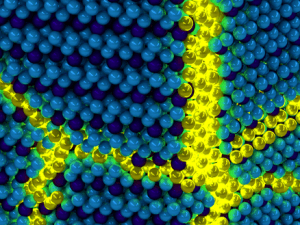Dec 11 2017
Excitons are pairs of holes and electrons present inside a solid material that together act like just one particle. For a long time, it has been assumed that when a number of such excitons exist in the same piece of matter, they can produce a single giant quantum state known as a Bose-Einstein condensate – the same process which is considered to be responsible for a metal losing all of its electrical resistance when it develops into a superconductor, for instance.
 Artist’s depiction of the collective excitations of an exciton condensate. These excitations can be thought of as propagating domain walls (yellow) in an otherwise ordered solid exciton background (blue). Image courtesy of Peter Abbamonte, University of Illinois Department of Physics and Frederick Seitz Materials Research Laboratory
Artist’s depiction of the collective excitations of an exciton condensate. These excitations can be thought of as propagating domain walls (yellow) in an otherwise ordered solid exciton background (blue). Image courtesy of Peter Abbamonte, University of Illinois Department of Physics and Frederick Seitz Materials Research Laboratory
However, for decades, really proving that Bose-Einstein condensation of excitons happens in any real material has indeed been a challenge for physicists. An experiment performed at the University of Illinois at Urbana-Champaign, in partnership with UvA-Institute of Physics researcher Jasper van Wezel, has managed to reveal evidence that this mysterious state of matter actually does exist. Their results were featured in the recent edition of Science.
Physicists, in the early 20th century, discovered that the world existing around human beings is made up of two types of particles: fermions and bosons. The key difference between these particles refers to how they perform when one attempts to bring them into the same physical state, with the same velocity, the same position, and so on. While it is basically impossible for two fermions (such as electrons) to ever be in the precisely same state, two or more bosons (such as photons, referring to particles of light) can indeed be in the very same state simultaneously without any problems. In fact, at temperatures that are adequately low enough, collections of bosons will favor such a situation: the particles are capable of occupying the same state, in a process called Bose-Einstein condensation.
Excitons
For several types of bosons, Bose-Einstein condensation occurs at extremely low temperatures, close to absolute zero, which is 273 degrees below zero on the Celsius scale. One exception to this rule could refer to the behavior of excitons within a crystal. Excitons refer to combinations of negatively charged electrons and holes - the absence of an electron anywhere in the crystal, causing a local surplus of positive charge. It is possible for pairs of electrons and holes to be bound together and act like the exciton, a single bosonic particle.
In the 1960s, it was predicted that just like other bosons, excitons are also capable of forming Bose-Einstein condensates. Furthermore, this should occur at much greater temperatures than for most other particles – in theory it could occur even at room temperature. In a laboratory setting, greater temperatures are much easier to reach, and due to this excitons will be ale to provide an accessible setting in which both the uncommon quantum properties of the Bose-Einstein condensates themselves, and also the exceptional material properties they grant upon their host crystals, can be examined.
M-EELS
In spite of the comparatively high temperature at which the effect defined in the Science article occurs (only 100 °C or so below room temperature), and despite the existence of excitons having been suspected for a number of years, demonstrating beyond doubt that excitons really do produce a Bose-Einstein condensate turned out to be unexpectedly complex. The key reason refers to the fact that there is a different physical phenomenon which is tough to distinguish from a Bose-Einstein condensate of excitons: the development of a Peierls state, where electrons within a crystal structure instinctively organize in a wave-like manner, along with alternating troughs and peaks of electron density. This type of a wave is known to have a number of the same physical characteristics anticipated for a Bose-Einstein condensate of excitons.
A new experiment performed at the University of Illinois at Urbana-Champaign, in association with researchers at the University of Oxford, and the University of Amsterdam, has proved that the recently produced experimental technique of Momentum-resolved Electron Energy-loss Spectroscopy (M-EELS for short) does permit them to differentiate unique signatures of condensed excitons in a material known as titanium diselenide. This technique was produced at the University of Illinois in Urbana-Champaign, and for the very first time permits researchers to measure low-energy bosonic particles developed from holes and electrons, irrespective of their momentum. This unique ability allowed the researchers to prove that excitons in titanium diselenide agglomerate spontaneously into a Bose-Einstein condensate when the material is cooled down to less than 100 °C below room temperature.
Science
For the very first time, these measurements provide compelling evidence for the fact that excitons can develop a Bose-Einstein condensate at comparatively high temperatures that are easily accessible. Furthermore, they demonstrate that M-EELS is a versatile and powerful new technique with a number of possible future applications. The results have been featured in the latest edition of Science.